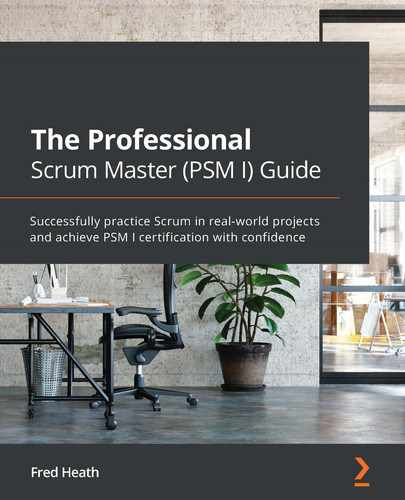Implement modern and industry-proven Scrum techniques to achieve business agility and prove your credentials by passing the PSM I certification exam Agile methodologies allow companies to maximize value and deal effectively with risks, which is why most IT companies adopt Agile in their workflows. Scrum is an Agile framework used to manage and execute projects with small teams. The Professional Scrum Master (PSM I) Guide will help you to explore the Scrum framework's rules and theories for Agile project management and develop skills that will enable you to become an indispensable resource for any organization. You'll learn essential techniques and practices such as estimation, planning, and forecasting that will help you to apply Scrum successfully and complete complex projects with ease. The book also demonstrates how to conduct Scrum events, create Scrum artifacts, and tackle issues faced during the Scrum life cycle, among other practices. Finally, you will focus on various aspects of the PSM I certification course and discover expert advice, tips, and quizzes to prepare yourself for the exam. By the end of the book, you will have gained fundamental knowledge of the Scrum framework, covered a range of topics related to the PSM I exam, and learned best practices, tips, and techniques to pass the exam confidently. This book is for professionals who want to build a strong foundation in Scrum practices and development. Project managers, product owners, product managers across various industries, sectors, and departments, software architects, developers, coders, and testers looking to achieve PSM certification will also find this book helpful.Key Features
Book Description
What you will learn
Who this book is for
Table of Contents
- The Professional Scrum Master (PSM I) Guide
- Contributors
- About the author
- About the reviewer
- Preface
- Section 1: The Scrum Framework
- Chapter 1: Introduction to Scrum
- What is Agile software development?
- What is Scrum?
- The value of an iterative and incremental approach
- The waterfall legacy
- Iterative and incremental software development
- Why should you choose Scrum?
- Introducing PSM assessments
- Scrum organizations and their history
- The PSM I assessment
- Summary
- Further reading
- Chapter 2: Scrum Theory and Principles
- Chapter 3: The Scrum Team
- Identifying a Scrum Team
- Defining a Scrum Team
- Introducing the Scrum Master
- Scrum Master responsibilities
- Things outside the Scrum Master realm
- Scrum Master Q&A
- Working with the Product Owner
- Product Owner responsibilities
- Things outside the Product Owner realm
- Product Owner Q&A
- Getting acquainted with the Developers
- The Developers are self-managing
- The Developers are a cross-functional group
- Developer structure
- Developer responsibilities
- Things outside the Developers' realm
- Developer Q&A
- Summary
- Questions
- Chapter 4: Scrum Events
- Getting ready to Sprint
- Deciding on the Sprint duration
- Setting the Sprint Goal
- Defining Done as working and potentially shippable software
- Starting the Sprint with Sprint Planning
- Sprint Planning for the Scrum Master
- Sprint Planning for the Product Owner
- Sprint Planning for the Developers
- Keeping on the right track with the Daily Scrum
- Inspecting the product during the Sprint Review
- Inspecting the team with the Sprint Retrospective
- Summary
- Questions
- Further reading
- Chapter 5: Scrum Artifacts
- Understanding the value of Scrum Artifacts
- Creating and managing the Product Backlog
- Making a commitment – the Product Goal
- Creating Backlog items as user stories
- Creating Product Backlog items as features
- Refining the Product Backlog
- Creating and managing the Sprint Backlog
- Making a commitment – the Sprint Goal
- Planning for the Sprint
- Producing a Product Increment
- Making a commitment – Definition of Done
- Summary
- Questions
- Further reading
- Section 2: Scrum in Action
- Chapter 6: Planning and Estimating with Scrum
- Managing the art of estimation
- Choosing an estimation scale
- Creating a baseline
- Playing Planning Poker
- Estimating backlog items using the bucket method
- Planning ahead with the product roadmap
- Envisioning the product journey with a product roadmap
- Forecasting with velocity and burn charts
- Calculating team velocity
- Burndown charts
- Burnup charts
- Summary
- Questions
- Further reading
- Chapter 7: The Sprint Journey
- Refining the Product Backlog
- Learning how to apply order to the Product Backlog
- Scrum Master duties for Product Backlog refinement
- Preparing for the first Sprint
- Tracking progress with a Scrum Board
- What to do when the Sprint Goal is not achieved
- Managing defects
- Dealing with defects in the current Sprint
- Dealing with defects from previous Sprints
- Canceling the Sprint
- What to do with the Sprint Backlog items
- How to wrap up a canceled Sprint
- Summary
- Questions
- Further reading
- Chapter 8: Facets of Scrum
- Learning software development practices for Scrum
- Source control model for continuous integration
- Continuous delivery and continuous deployment
- Leveraging testing methods for Scrum
- Applying Scrum to remote teams
- Managing technical debt
- How is technical debt created?
- How to pay back technical debt
- Scaling Scrum
- Summary
- Questions
- Section 3: The PSM Certification
- Chapter 9: Preparing for the PSM I Assessment
- Assessments
- Other Books You May Enjoy
